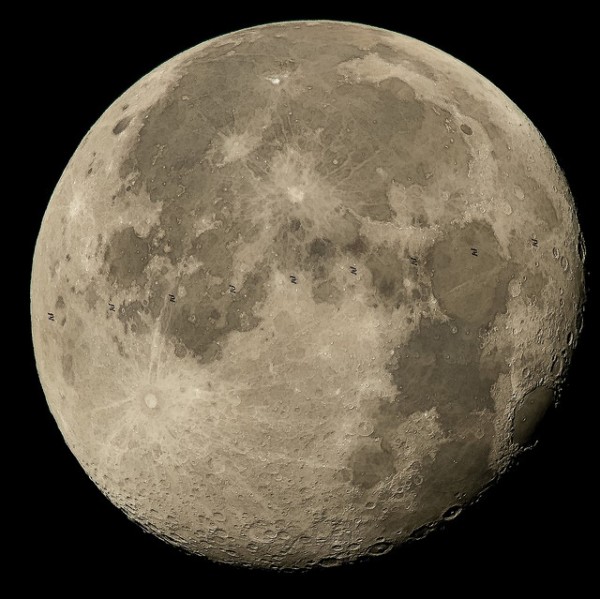Asteroids Not Comets Brought Water to the Moon 4.5 Billion Years Ago
| Ana Verayo | | Jun 01, 2016 07:36 AM EDT |
(Photo : NASA/Bill Ingalls) This composite image made from nine frames shows the International Space Station, with a crew of six onboard, as it transits the moon at roughly five miles per second, Sunday, Aug. 2, 2015, Woodford, VA.
Is there any water on the surface of the moon? Scientists now say that around 80 percent of the moon's inner water system was formed some 4 billion years ago, due to asteroid collisions and not necessarily comets.
Scientists have long thought that our natural satellite has been completely dry, based on lunar rocks brought home from NASA's Apollo missions during the late 1960s. However, there have been more advanced techniques that were developed in recent years showing evidence of signs of water from those samples, according to co-author of the study, planetary scientist, David Kring from the Lunar and Planetary Institute in Houston.
Like Us on Facebook
Kring revealed that even if the surface of the moon appears to be arid and extremely devoid of life and pockmarked with impact craters, there coud be 10 million times more water than the surface can actually contain.
Kring explains that asteroids are also rich in water or can potentially hold water, since water is more often than not locked into the molecular structure of clay and the majority of the scientific community are more likely to view those moon rocks to be inherently dry, which is not the case at all.
In this new study, an international team of researchers collected data from different studies and analyzed these lunar rocks and meteorites from asteroids that entered the Earth's atmosphere. Scientists then analyzed the composition of the volatile elements in these space rocks, where they determined the ratio of hydrogen to deuterium.
This hydrogen to deuterium ratio is considered as a type of "fingerprint" where scientists can base the origins of the moon's water, whether or not if water came from comets or asteroids.
Results from this intensive analyses revealed that the moon's water came from mostly asteroids and not comets, even if past studies have shown that comets are rich in water and ice.
Scientists say that some 4.5 to 4.3 billion years back, this was a time when the planet is still in its "late accretion window" where more than 80 percent of the moon's water originated from different types of asteroids and 20 percent from comets. During this time, the young moon was covered in an ocean of magma where incoming asteroids have instantly been absorbed into the lunar core.
These new findings can also aid in future research about the driving forces during the early formation of the solar system, and revealing more crucial clues about how asteroids brought water into Earth and lunar systems.
This new study is published in the journal, Nature Communications.
Tagsmoon, moon water, lunar rocks, water on moon asteroids, asteroids, comets, solar system, Earth
©2015 Chinatopix All rights reserved. Do not reproduce without permission
EDITOR'S PICKS
-

Did the Trump administration just announce plans for a trade war with ‘hostile’ China and Russia?
-

US Senate passes Taiwan travel bill slammed by China
-

As Yan Sihong’s family grieves, here are other Chinese students who went missing abroad. Some have never been found
-

Beijing blasts Western critics who ‘smear China’ with the term sharp power
-

China Envoy Seeks to Defuse Tensions With U.S. as a Trade War Brews
-

Singapore's Deputy PM Provides Bitcoin Vote of Confidence Amid China's Blanket Bans
-

China warns investors over risks in overseas virtual currency trading
-

Chinese government most trustworthy: survey
-

Kashima Antlers On Course For Back-To-Back Titles
MOST POPULAR
LATEST NEWS
Zhou Yongkang: China's Former Security Chief Sentenced to Life in Prison

China's former Chief of the Ministry of Public Security, Zhou Yongkang, has been given a life sentence after he was found guilty of abusing his office, bribery and deliberately ... Full Article
TRENDING STORY

China Pork Prices Expected to Stabilize As The Supplies Recover

Elephone P9000 Smartphone is now on Sale on Amazon India

There's a Big Chance Cliffhangers Won't Still Be Resolved When Grey's Anatomy Season 13 Returns

Supreme Court Ruled on Samsung vs Apple Dispute for Patent Infringement

Microsoft Surface Pro 5 Rumors and Release Date: What is the Latest?










